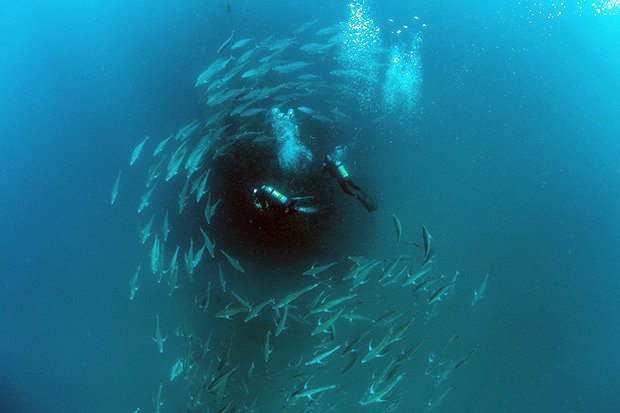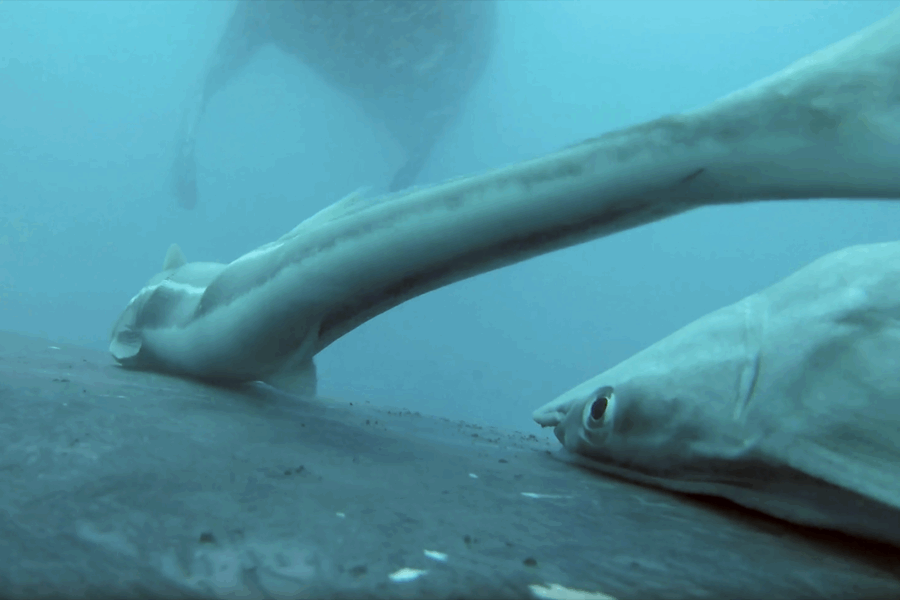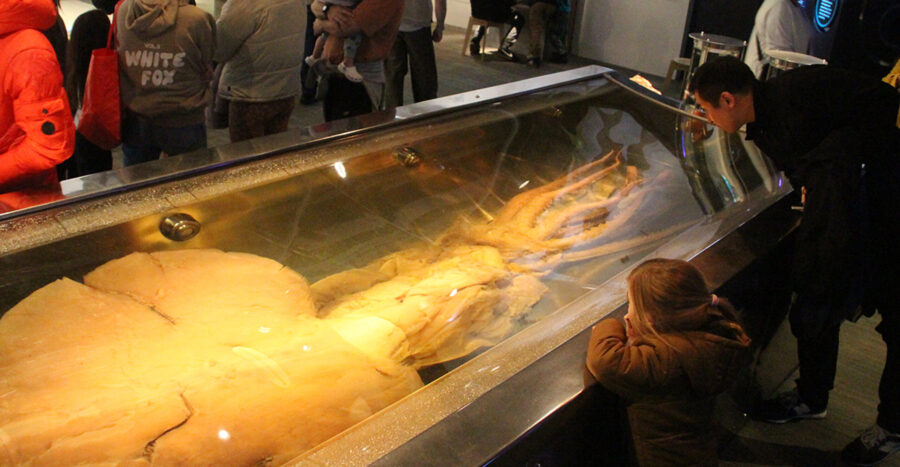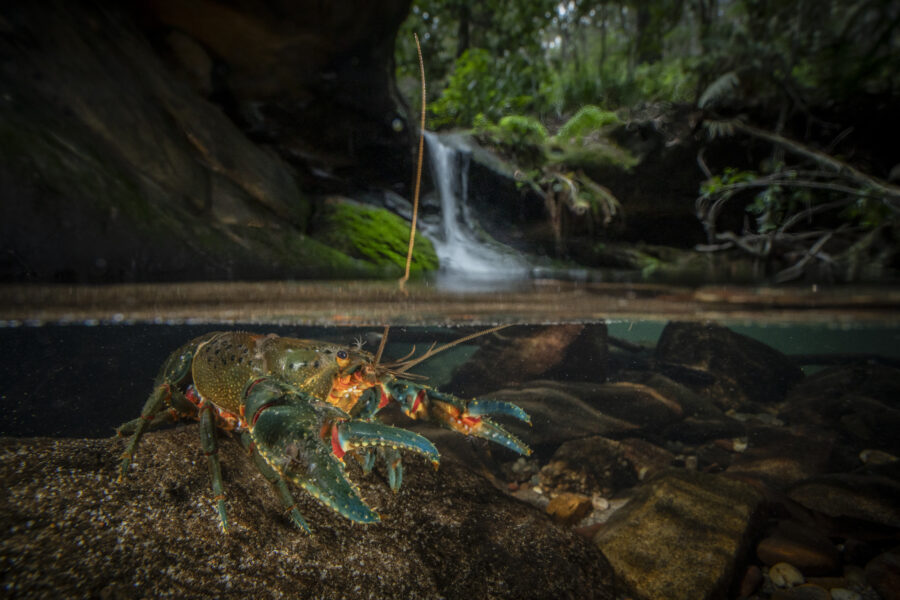Reef life on the wreck of the Yongala

MOMENTS BEFORE THE SS Yongala left the northern Queensland port of Mackay, on 23 March 1911, captain William Knight received warning of a possible cyclone brewing in the vicinity of its destination. But the 62-year-old Knight had weathered many cyclones before, and the large, iron-hulled steamship was well-built and well-equipped.
The Yongala was almost eight years old and in prime condition, serviced and maintained with pride by its owner, the Adelaide Steamship Company. It was capable of handling big seas and had a schedule to keep. At this time in Australia, the movements of ships such as the i were anticipated and relied upon by tens of thousands of people.
Her next stop was Townsville – then, an isolated frontier town of 18,953 with few connections to the outside world. But in a tragedy as momentous and unfathomable as if a passenger jet vanished today without trace, neither the Yongala nor the 122 people aboard ever reached harbour.

SS Yongala wreck. (Image: Darren Jew)
THE YONGALA WAS one of several coastal traders that serviced Australia’s major ports. But this fast and luxurious vessel was in a league of its own as it plied the populous eastern seaboard, from Melbourne to Cairns. Today, even as it lies submerged and slowly corroding 15–30m down, the ship remains something special. Since becoming a gravesite more than 100 years ago, the Yongala has evolved into a unique artificial reef, now regarded as one of the world’s greatest scuba diving experiences.
“You get this amazing abundance of wildlife… It really is mind-blowing,” says marine biologist Dr David Wachenfeld. This is one of the main reasons the site in the Great Barrier Reef (GBR) Marine Park, due east of Cape Bowling Green, is now enjoyed by more than 7000 divers a year.
The 110m-long wreck lies 20km inshore from the nearest ribbons of natural hard coral reef. It rests on a predominately flat and featureless underwater ‘plain’ of sand that stretches away in all directions like a marine desert. The Yongala, in contrast, is an oasis.The waters around her ripple with huge numbers of large fish, including many of northern Queensland’s most prized sport and table species. Being in a designated marine park green zone means that no fishing or collecting is allowed in the waters around the Yongala, which has undoubtedly helped maintain the biological richness of the location.
David is a recreational diver and amateur underwater photographer in addition to being a scientist. He visits the Yongala several times a year for the sheer pleasure of it, and has done so for 20 years. “There are incredible schools of giant trevally and other trevally, barracuda, small- and large-mouth nannygai and other snappers, and lots of emperors,” he says. As well as “schools of cardinal fish in numbers you couldn’t even estimate.” At times the fish aggregations are so dense they obscure the wreck.
The site is also known for its resident giant groupers that lurk, mostly solo, watching territories near cave-like entrances to the disintegrating hull. Filter-feeding whale sharks sometimes take advantage of the area’s plankton-rich waters, gliding slowly overhead. Occasionally, humpback whales also swim close by as they migrate to or from northern calving grounds. And then there are sea snakes, marine turtles, bull sharks, eagle rays and occasionally large manta rays, adding to a marine menagerie unlike anything seen elsewhere within the GBR Marine Park.
“And, before [Cyclone] Yasi in 2011, if you looked at the wreck from 20m away…it seemed as though it was covered with fur,” David says. “But when you moved closer, and looked more carefully you’d see she was absolutely chock-a-block with filter-feeding invertebrates.” These small, sedentary creatures live permanently attached to the Yongala, and are a clue as to why there’s so much life. Yasi removed some of this covering but it’s recovering rapidly.
Yongala wreck created a dynamic reef site
THE DYNAMIC biological community thriving at the Yongala wreck site is an ecological anomaly that has resulted from a serendipitous combination of events and circumstance. And it began, of course, with the sinking of the Yongala into the underwater realm.
That truly tragic event is thought to have taken place just before midnight on 23 March 1911 – a little more than a year before the Titantic famously hit an iceberg in the North Atlantic Ocean. We can be confident about the time of the Yongala’s demise, says Paddy Waterson, marine archeologist with the Queensland Department of Environment and Heritage Protection, because divers later recovered the ship’s clock and chronometers, the former set on local time and the later on Greenwich Mean Time. All had stopped within a minute of each other.
On the day the Yongala went down, it was about three-quarters of the way through its 99th voyage in Australian waters. It was built in England for the Adelaide Steamship Company and began its working life ferrying passengers from Western Australia’s goldfields to Adelaide, Melbourne and Sydney. Its role servicing the east coast began in 1906.
It was on a routine journey from Melbourne to Cairns on the day it went missing and had left the port of Mackay early in the afternoon, just before 2pm. On board were 73 crew, 29 first-class passengers, 20 second-class passengers and more than 600 tonnes of cargo and livestock, including two bulls and a racehorse named Moonshine.
The Dent Island lighthouse keeper sighted the Yongala just after 6pm, steaming northwards past the Whitsunday islands at up to 17 knots (about 32km/h). It had no radio on board and was headed into the path of a cyclone. The ship was, Paddy says, due to be fitted with a Marconi wireless radio – the latest in communication technology – which had already been dispatched from England. But the Yongala never made it to her next port, Townsville, and was listed as missing on 26 March.
A massive search was mounted. But, as wreckage and then the body of Moonshine washed up along the coast less than 200km from where the vessel was last sighted, hope was abandoned for the crew and passengers. A Marine Board of Queensland inquiry convened in June that year concluded that the boat was seaworthy, and its disappearance was one of “the mysteries of the sea”.
Yongala wreck the base of a diverse reef
FROM A BIOLOGICAL perspective, the most significant feature about the Yongala is that it became a hard substrate on an otherwise sandy sea floor. The waters where it lies are relatively nutrient-rich due to coastal run-off from the Cape Bowling Green estuary just 12 nautical miles (22km) to the west.
The wreck is exposed to strong currents that operate as if they are planktonic highways, transporting a supply of minuscule plant and animal life past the wreck. Plankton includes the larval free-swimming dispersal stages of both fishes and invertebrate animals that have sedentary adult lives, such as sponges, and soft and hard corals.
While suspended in the water column, these tiny creatures are primed to detect locations suitable for settling, which is exactly what the Yongala is; an attachment site, shallow enough to receive traces of sunlight and bathed in nutrients. These come from the coastal run-off and the wreck also fertilises the surrounding water as its metal corrodes and releases iron. It’s a well-known phenomenon that iron added to seawater initiates blooms of planktonic algae. And wherever there’s lush plant life, no matter how small, animal life quickly follows.
Once a few animals settle on a location, reefs can build at an exponential pace. Research has shown that their noises and smells can, similar to the neon lights of a city, be detected from afar and draw more and more passing travellers looking for a home.
There’s equilibrium of sorts – perhaps even a kind of symbiotic relationship – that’s developed between the wreck and the community it supports, explains Paddy. Growth of the Yongala’s invertebrate life is catalysed by the iron released by corrosion. But the dense covering of life also slows the process, because it partially seals the ship’s metal from direct contact with seawater. And so, as more and more life has settled on the Yongala, it seems to have helped preserve, rather than hasten, its demise.
“Basically, the Yongala has already held together longer than a lot of iron shipwrecks and it’s the artificial reef that’s formed over it that’s protected it,” Paddy says. “It’s helped to hold the ship together.” Just how well the relationship has worked was revealed in early 2011 after Cyclone Yasi sandblasted the soft corals and other invertebrates from the wreck’s upper level, revealing fine details such as rivets.
The role of plankton in underpinning the biological diversity of the Yongala was highlighted in a fish survey carried out during a 15-month period in the 1990s by researchers at the Australian Institute of Marine Science (AIMS), and Queensland Department of Environment and Heritage.
It identified 122 species of fish in 27 different families, but Alistair Cheal, an ecologist at AIMS and one of the survey’s researchers, believes the number of fish was underestimated. The survey focused on large, obvious species, but he says that if smaller, more cryptic species – such as gobies and blennies – were included, the count would rise by as many as 30.
Whatever the number, it’s the types of fish that thrive at the Yongala that helps create a unique biological community. There’s a profusion of fish at two particular stages in the food chain. First, there are massive numbers of plankton eaters, including fusiliers and damselfish, at the lower trophic levels. Second, there are huge numbers of predators at the top levels, with fewer species filling the gaps between.
The GBR has more than 2900 natural reefs and no need for artificial versions. But the extraordinary diversity and abundance of life at the Yongala provides a striking example of the impacts that artificial reefs can have on the natural marine environments.
The ghost ship, Yongala
MYSTERY SURROUNDED the fate of the Yongala for decades and stories emerged of a ghost ship in the area where it disappeared. During World War II, a minesweeper reported a possible sandbank in the area. In 1947 there was further speculation following reports from a naval hydrographic vessel. The Yongala was finally located by divers in 1958, after a fisherman hoping to make a salvage claim dragged a grappling hook through the area.
There are, says Paddy, many theories about what happened. There are no rocks nearby but the effect of tidal flow in that area, combined with the impact of massive seas created by the cyclone, meant the ship would have been riding enormous waves. Wave heights of more than 9m were recorded there during 2011’s Cyclone Yasi.
“One of the most popular theories is [the Yongala] kept taking water, the pumps couldn’t cope and eventually it just couldn’t breach out of the waves and the bow went down – straight down,” says Paddy. No life rafts were launched and people were still in their cabins, many undoubtedly suffering from seasickness. The Yongala, it appears, was swallowed by the sea.




